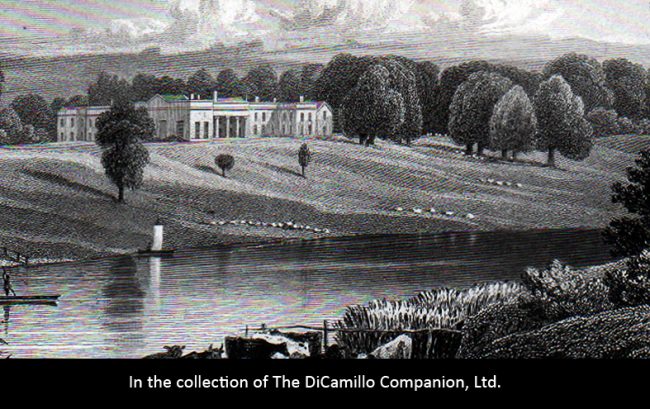
An 1829 engraving of the house from "Neale's Views of Seats"
Earlier Houses: There was a house here as early as the 13th century.
House & Family History: In 1932 the Smith-Barry family sold the Marbury Estate for use as a country club. In 1940 the house was requisitioned by the government for war use, during which time British soldiers camped in the park, including survivors from Dunkirk. Later Marbury became Camp 180, a prisoner-of-war camp. After the war ended the house was sold to Imperial Chemical Industries, who used it to house Polish workers. Marbury was not maintained well; it fell in disrepair and was demolished in 1968. All that remains today of Marbury Hall are two rusticated gate piers and a section of the walled garden.
Garden & Outbuildings: The former grounds of the house now form part of the public Marbury Park.
John Bernard (J.B.) Burke, published under the title of A Visitation of the Seats and Arms of the Noblemen and Gentlemen of Great Britain and Ireland, among other titles: Vol. I, p. 200, 1852.
John Preston (J.P.) Neale, published under the title of Views of the Seats of Noblemen and Gentlemen in England, Wales, Scotland, and Ireland, among other titles: 2.S. Vol. V, 1829.
Title: Cheshire Country Houses
Author: de Figueiredo, Peter; Treuherz, Julian
Year Published: 1988
Reference: pg. 252
Publisher: Sussex: Phillimore & Co. Ltd.
ISBN: 0850336554
Book Type: Hardback
House Listed: Demolished
Park Listed: Not Listed
Past Seat / Home of: Marbury (Merbury) family, until 1684. Richard Savage, 4th Earl Rivers, 17th century. James Barry, 4th Earl of Barrymore, early 18th century; John Smith-Barry, 19th century; Smith-Barry family here until 1932.
Current Ownership Type: Demolished
Primary Current Ownership Use: Demolished
House Open to Public: No
Historic Houses Member: No